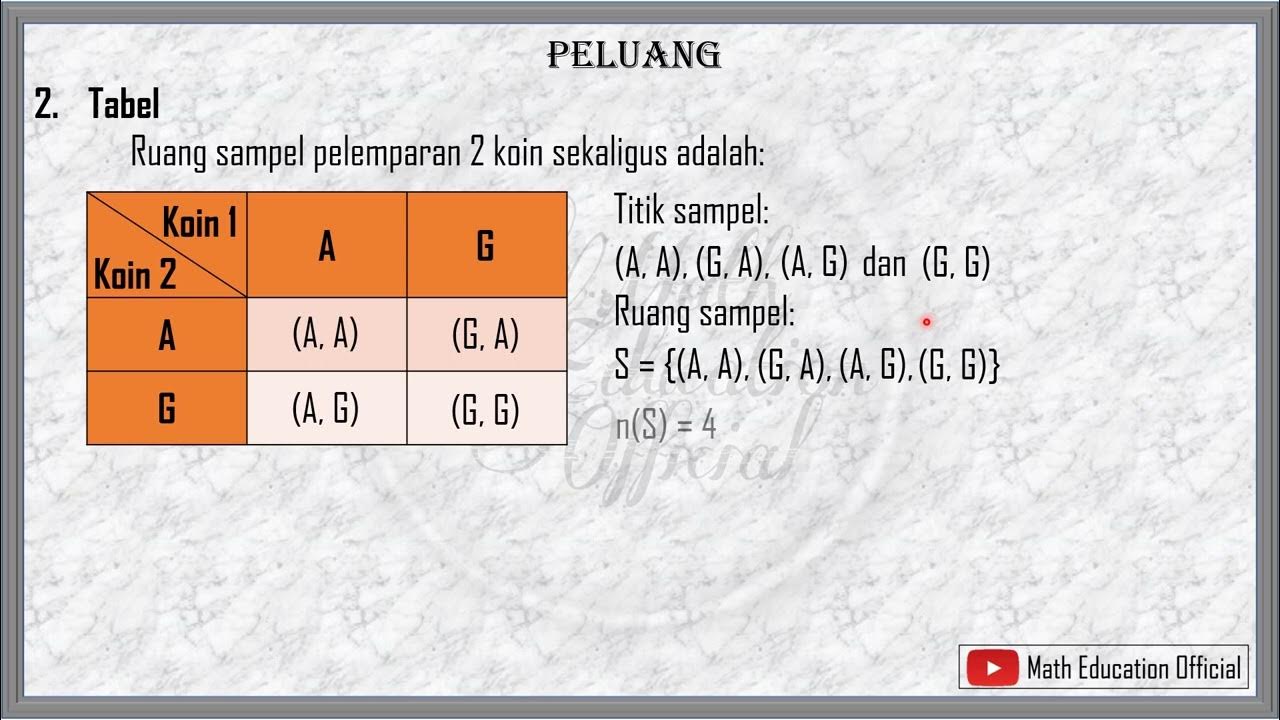MENENTUKAN RUANG SAMPEL DAN TITIK SAMPEL PELUANG PART 1
Summary
TLDRIn this video, Ayu introduces the concept of probability, focusing on determining sample spaces and sample points. She explains key terms such as sample space, sample points, and events, using practical examples like tossing coins and rolling dice. Through visual aids and diagrams, Ayu demonstrates how to calculate the number of possible outcomes in different scenarios, such as tossing multiple coins or rolling multiple dice. The video also covers how to apply formulas for calculating sample spaces and how to solve probability problems related to real-life situations.
Takeaways
- 😀 Probability is the likelihood of an event occurring, and it is based on the sample space and sample points.
- 😀 Sample space (S) is the set of all possible outcomes of an experiment or event.
- 😀 The number of elements in a sample space can be denoted as N(S), where N represents the total count.
- 😀 Sample points are the individual outcomes within the sample space.
- 😀 An event is a subset of the sample space, representing the occurrence or non-occurrence of specific outcomes.
- 😀 A coin toss has a sample space of two possible outcomes: heads (H) and tails (T).
- 😀 When tossing two coins, the sample space includes all combinations of heads and tails, resulting in four outcomes.
- 😀 The sample space for tossing three coins has eight possible outcomes, which can be visualized using a tree diagram.
- 😀 A die roll has a sample space of six possible outcomes, corresponding to the six faces of the die.
- 😀 For multiple dice, the total number of possible outcomes is calculated as 6^n, where n is the number of dice being rolled.
Q & A
What is probability and how is it defined?
-Probability refers to the likelihood or chance of an event occurring. It represents the value of the possible outcomes of an event. The sample space (S) consists of all possible outcomes of a trial or experiment.
What is a sample space in probability?
-The sample space is the set of all possible outcomes of a random experiment. It is usually denoted by 'S'. For example, when tossing a coin, the sample space would consist of two outcomes: heads and tails.
What is a sample point in probability?
-A sample point is an individual outcome within the sample space. It represents one specific result of a trial. For instance, in the sample space of a coin toss (heads, tails), 'heads' is a sample point.
What is an event in the context of probability?
-An event is a subset of the sample space. It represents a specific outcome or a combination of outcomes that we are interested in. For example, getting heads in a coin toss is an event.
How do you determine the sample space for tossing two coins?
-For two coins, the sample space can be determined by listing all possible outcomes: (Heads, Heads), (Heads, Tails), (Tails, Heads), and (Tails, Tails). The total sample space has four outcomes.
How is the sample space for three coins different from two coins?
-For three coins, each coin has two possible outcomes (Heads or Tails), so the total number of possible outcomes is 2^3, which equals 8. The sample space would consist of all combinations of heads and tails for the three coins.
What formula is used to calculate the sample space for multiple coins?
-The formula for calculating the sample space for multiple coins is 2^n, where 'n' represents the number of coins. For example, for 3 coins, the sample space is 2^3 = 8.
How do you calculate the sample space for throwing two dice?
-For two dice, each die has six possible outcomes (1 through 6). The total number of possible outcomes is 6^2, or 36, since each die can land on any of six faces, independent of the other.
How do you find the number of favorable outcomes for a specific event in a sample space?
-To find the number of favorable outcomes for a specific event, you simply count how many outcomes in the sample space meet the criteria for the event. For example, if you want to find the number of outcomes where a die roll results in a sum of 8, you would count all pairs of numbers on two dice that add up to 8.
What is the probability of an event occurring when the sample space is known?
-The probability of an event is calculated by dividing the number of favorable outcomes by the total number of outcomes in the sample space. For example, if an event has 3 favorable outcomes out of 10 total outcomes, the probability is 3/10.
Outlines

Cette section est réservée aux utilisateurs payants. Améliorez votre compte pour accéder à cette section.
Améliorer maintenantMindmap

Cette section est réservée aux utilisateurs payants. Améliorez votre compte pour accéder à cette section.
Améliorer maintenantKeywords

Cette section est réservée aux utilisateurs payants. Améliorez votre compte pour accéder à cette section.
Améliorer maintenantHighlights

Cette section est réservée aux utilisateurs payants. Améliorez votre compte pour accéder à cette section.
Améliorer maintenantTranscripts

Cette section est réservée aux utilisateurs payants. Améliorez votre compte pour accéder à cette section.
Améliorer maintenantVoir Plus de Vidéos Connexes
5.0 / 5 (0 votes)






